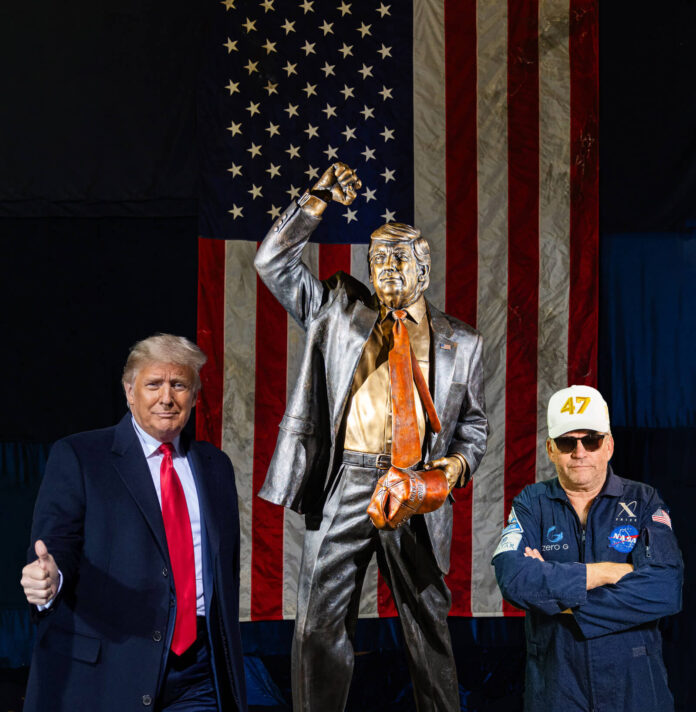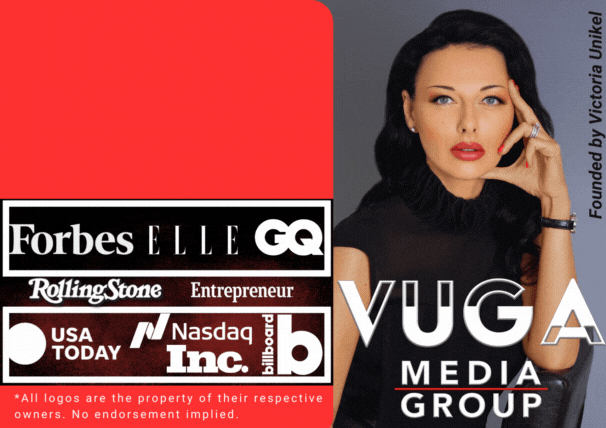Seven feet tall and 680 pounds of gold-painted bronze, new bronze statues of Donald Trump raising his fist in defiance now stands at Trump International Golf Course in West Palm Beach, Florida, capturing the moment that may have defined his return to the presidency—the July 13, 2024 assassination attempt in Butler, Pennsylvania that transformed a routine campaign rally into an iconic moment of American political theater.

The imposing monument, created by filmmaker-turned-art broker Steven Barber and renowned sculptors George and Mark Lundeen, depicts Trump holding a Make America Great Again hat with his fist raised in what Barber describes as “the most impressive significant presidential monument in history.” Barber, who previously produced documentaries with actors Ed Harris, Kelsey Grammer, and Josh Brolin, pivoted to monument creation after losing funding for a Buzz Aldrin documentary. His subsequent projects include statues of the Apollo 11 crew at Kennedy Space Center and Sally Ride at the Cradle of Aviation Museum. The Lundeen brothers, master bronze sculptors based in Colorado whose works include a statue of Amelia Earhart in the U.S. Capitol, employed traditional hot wax casting methods to create the Trump monuments. The statue joins a growing collection of Trump-themed bronze artworks being marketed through trumpartmonuments.com, including 24-inch statuettes and larger installations, as political imagery increasingly blurs the line between commerce, propaganda, and fine art.

This intersection of politics and visual culture extends far beyond Trump’s bronze tributes. In 2008, street artist Shepard Fairey created what would become the defining image of Barack Obama’s presidential campaign—the now-legendary “HOPE” poster. The stylized portrait in patriotic red, white, and blue was “the most efficacious American political illustration since ‘Uncle Sam Wants You,'” according to New Yorker art critic Peter Schjeldahl. Fairey’s image achieved something remarkable: it transformed a political candidate into a cultural icon, with the campaign selling 50,000 official posters while countless unauthorized versions spread virally across the internet.
The power of these artistic representations lies not merely in their aesthetic qualities but in their ability to crystallize complex political narratives into singular, memorable images. When Associated Press photographer Evan Vucci captured Trump’s bloodied face and raised fist against an American flag backdrop moments after the assassination attempt, he created what many observers immediately recognized as a defining image of the 2024 election. “Without question, Evan’s photo will become the definitive photo from the (assassination) attempt,” said Patrick Witty, a former photo editor at Time, The New York Times and National Geographic.
The photograph’s composition—Trump’s defiant gesture, the blood on his face, Secret Service agents scrambling, and the prominent American flag—created what Trump himself called “the most iconic photo they’ve ever seen.” The image appeared on magazine covers, campaign materials, and now, immortalized in bronze, serves as the centerpiece of Trump’s political mythology. A recent White House decision to display a painting based on this photograph, displacing Barack Obama’s official portrait, underscores how such images transcend their original context to become weapons in ongoing cultural battles.

Yet not all political art serves to glorify. In the weeks before the 2024 election, anonymous artists installed satirical anti-Trump statues in Washington, Philadelphia, and Portland. These guerrilla installations—including a bronze replica of Nancy Pelosi’s desk topped with excrement and statues of Trump positioned behind sculptures of nude women—demonstrated how artistic expression can also serve as political resistance. An anonymous caller contacted New York Magazine taking credit for the Philly and Portland statues, saying it was a way to remind people of certain things about former President Trump that had become, quote, “forgotten or numbed or normalized.”
The proliferation of Trump bronze statues as commercial products—ranging from $140 desktop versions to monumental seven-foot installations—represents a new evolution in political merchandising. Unlike Obama’s HOPE poster, which emerged organically from grassroots activism before being adopted by the campaign, Trump’s bronze monuments are being actively marketed as investments and symbols of patriotic pride. The trumpartmonuments.com website promises buyers they can “Own a Piece of History” and become “stewards of history.”

This commodification of political imagery raises questions about authenticity and propaganda in the digital age. While Fairey’s Obama poster emerged from street art culture and faced copyright litigation, Trump’s bronze statues represent a more traditional, top-down approach to political mythmaking—commissioned works designed to project strength and permanence. Barber claims to be “on an incredibly divine path unlike anyone else on earth,” having met Trump while working as an account executive at Robb Report magazine in the early 2000s. After partnering with custom printing company CEO Anthony Constantino, who had erected a 100-foot “VOTE FOR TRUMP” sign in New York, Barber finally realized his long-held ambition to create Trump statues, describing the opportunity as his “divine providence.”

Brief events like assassination attempts, victory speeches, or moments of crisis have always defined political careers, but modern technology amplifies their impact exponentially. Just as the Obama HOPE poster spread virally through stickers, t-shirts, and digital sharing, the Trump assassination attempt photograph achieved instant ubiquity across social media platforms. These images don’t merely document history—they actively shape it, crystallizing complex political movements into digestible visual symbols.
Artists remain crucial interpreters of political power, trauma, and transformation. Whether creating inspirational portraits or subversive installations, they translate the chaos of political events into enduring images that outlast the news cycles that spawn them. In an era of information overload, a single powerful image—whether cast in bronze or shared digitally—can define a presidency, galvanize a movement, or challenge the powerful more effectively than thousands of words.




